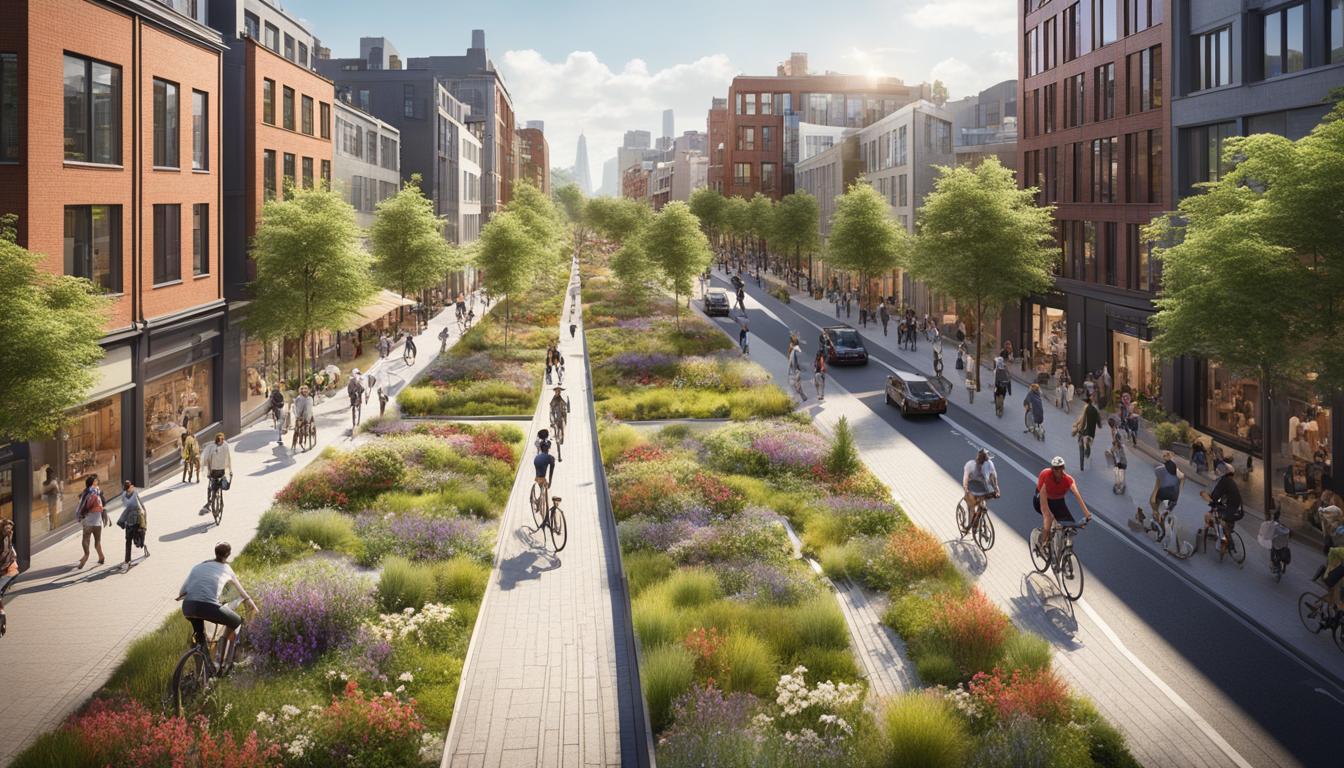Sustainable urban planning is crucial for creating livable and environmentally-friendly cities. It encompasses various aspects of urban development, including the incorporation of green spaces, the establishment of a multi-modal transportation system, and the promotion of mixed-use development. By adopting sustainable site planning strategies, cities can strike a balance between built and natural systems, preserving their historic, cultural, and environmental resources.
Diverse housing options within sustainable urban developments not only promote inclusivity and affordability but also contribute to the creation of vibrant and sustainable communities. Furthermore, by promoting walking, biking, and other alternative modes of transportation, cities can reduce pollution levels and enhance the overall mobility of their residents.
Key Takeaways:
- Sustainable urban planning aims to create livable and environmentally-friendly cities.
- It involves incorporating green spaces, multi-modal transportation systems, and mixed-use development.
- Sustainable site planning and construction techniques help preserve historic, cultural, and environmental resources.
- Diverse housing options promote inclusivity and affordability in sustainable urban communities.
- Promoting walking, biking, and alternative modes of transportation improves urban mobility and reduces pollution.
Fighting Sprawl
The proliferation of sprawl has become a pressing issue in urban development. This phenomenon is primarily driven by land-use based zoning, real-estate tax laws, and highway design regulations that prioritize automobile-dominated development.
Sprawl has detrimental effects on urban centers, leading to increased congestion, longer commute times, and a decline in overall livability. To address these challenges, it is essential to promote responsible and sustainable development practices.
Instead of expanding further into suburban or exurban areas, a more effective approach is to focus on in-fill development and the redevelopment of existing infrastructure. This strategy utilizes available resources efficiently, reduces the need for extensive new infrastructure, and preserves open green spaces within cities.
Promoting in-fill development and suburban redevelopment is crucial for combatting sprawl and creating more sustainable communities.
Responsible and innovative development strategies at the federal, state, and local levels can play a significant role in fighting sprawl. By adopting forward-thinking policies and regulations, government bodies can incentivize and support sustainable growth practices.

Furthermore, it is important to reconsider current land-use based zoning and real-estate tax laws that contribute to the sprawl phenomenon. By reassessing and updating these regulations, cities can encourage responsible development that aligns with sustainable growth objectives.
The fight against sprawl requires collaboration between different stakeholders, including urban planners, policymakers, developers, and local communities. It is crucial to prioritize the creation of urban centers that are vibrant, walkable, and offer a mix of residential, commercial, and recreational spaces.
By addressing the root causes of sprawl and implementing sustainable development practices, we can create cities that are more resilient, livable, and environmentally friendly.
| Factors Contributing to Sprawl | Countermeasures for Responsible Development |
|---|---|
|
|
Sustainable Zoning
When it comes to sustainable urban planning, one crucial aspect is the implementation of sustainable zoning. Unlike conventional zoning codes that primarily focus on land use, sustainable zoning goes beyond that and emphasizes controlling the physical form of development. This innovative approach ensures that urban development aligns with sustainability principles, creating well-designed and ecologically sound communities.
One effective strategy for sustainable zoning is the use of form-based codes. These codes prioritize creating mixed-use developments that are appropriately scaled and promote pedestrian-friendly public spaces. By considering the physical form of buildings and structures, these codes contribute to the overall sustainability of cities.
Form-based codes are a powerful tool in shaping the future of our cities. By focusing on the physical form of development, we can create communities that are not only aesthetically pleasing but also socially and environmentally sustainable. – Jane Thompson, Urban Planner
In addition to controlling physical form, sustainable zoning also involves comprehensive planning. This means taking into account various factors such as transportation, infrastructure, and environmental impact when determining the zoning regulations for different areas. Comprehensive planning ensures that sustainable development is integrated into every aspect of the city, leading to more cohesive and livable urban environments.
By adopting sustainable zoning codes, cities can shape their physical environments to be more inclusive, competitive, and ecologically sound. These codes promote sustainable development by encouraging a mix of land uses, creating walkable neighborhoods, and preserving green spaces. Ultimately, sustainable zoning plays a vital role in creating cities that are not only visually appealing but also environmentally friendly and socially equitable.
Benefits of Sustainable Zoning
Sustainable zoning offers a wide range of benefits for both residents and communities. Some of the key advantages include:
- Promotes walkable neighborhoods and reduces dependence on cars, leading to lower emissions and improved air quality
- Preserves natural resources, such as green spaces and water bodies, for the well-being of both humans and wildlife
- Fosters a sense of community by creating mixed-use developments that encourage social interaction and engagement
- Supports local businesses and promotes economic development by providing opportunities for diverse commercial activities
- Enhances the overall quality of life by creating visually appealing and well-designed urban environments
Implementing sustainable zoning codes requires collaboration between urban planners, policymakers, and community members. By working together, we can create cities that prioritize sustainability and ensure a better future for generations to come.
| City | Sustainable Zoning Approach |
|---|---|
| Portland, Oregon | Adopted form-based codes that prioritize walkability and mixed-use development |
| Seattle, Washington | Implemented comprehensive planning strategies that integrate transportation, housing, and environmental considerations |
| Copenhagen, Denmark | Focused on creating bike-friendly infrastructure and promoting sustainable transportation options |
Reusing Brownfields
Brownfields refer to abandoned areas that often have existing infrastructure but are underutilized and contaminated. Reusing these brownfield sites is crucial for urban revitalization and sustainable development. By transforming these neglected areas into thriving spaces, cities can reclaim valuable urban space and create new opportunities for a more sustainable future.
To support brownfield redevelopment, cities offer a range of incentives and resources. Grants and loan funds help finance the cleanup and revitalization efforts, making it more economically feasible for developers and landowners. Technical assistance is also available to guide them through the complex process of remediation and redevelopment. Cities may provide expertise in environmental assessment, zoning regulations, and project management to ensure sustainable reuse.
Furthermore, cities recognize the need to address the liability associated with brownfield cleanup and reuse. Legal protections are put in place to absolve landowners of the potential financial burden and legal consequences. These measures encourage property owners to take on the revitalization of brownfields, contributing to urban revitalization and the transformation of abandoned areas into vibrant and sustainable spaces.
| Benefits of Brownfield Redevelopment |
|---|
| 1. Urban Revitalization |
| 2. Sustainable Development |
| 3. Reclamation of Valuable Urban Space |
| 4. Economic Growth |
| 5. Job Creation |
| 6. Environmental Remediation |
By redeveloping brownfields, cities not only address the blight and contamination issues but also promote sustainable reuse of existing infrastructure. This reduces the pressure for new development on undeveloped land and protects valuable natural resources.

Through brownfield redevelopment, cities can revitalize and transform abandoned areas into vibrant and sustainable communities. By providing grants, technical assistance, and liability protections, cities create an environment that encourages developers and landowners to participate in the revitalization efforts. The reuse of brownfields not only brings economic growth and job opportunities but also contributes to sustainable urban development and the overall well-being of the community.
Conclusion
Sustainable urban planning plays a critical role in promoting green building and architecture. By incorporating sustainable design principles, eco-friendly construction techniques, energy-efficient buildings, and the use of green building materials, cities can reduce their environmental impact and create healthier, more sustainable communities. Certification programs like LEED (Leadership in Energy and Environmental Design) provide guidelines and incentives for sustainable building practices.
Additionally, incorporating renewable energy sources into construction projects further promotes sustainability in the built environment. From utilizing solar power to implementing geothermal systems, renewable energy in construction helps reduce reliance on fossil fuels and decreases carbon emissions. By embracing these practices, cities can create energy-efficient buildings that contribute to a greener future.
As cities continue to grow and urbanize, sustainable urban planning becomes increasingly important in creating a future that is both environmentally conscious and socially equitable. By prioritizing sustainability in community development, cities can enhance the quality of life for their residents, improve public health, and foster economic growth. From sustainable site planning to responsible zoning codes, it is crucial to consider the long-term environmental impact of urban development.
Investing in eco-friendly construction and sustainable design not only benefits the environment but also saves costs in the long run. Energy-efficient buildings reduce utility expenses, while green building materials promote the use of sustainable resources. By embracing the principles of green building and architecture, cities can pave the way for a more environmentally-friendly and resilient future.
FAQ
What is sustainable urban planning?
Sustainable urban planning involves guiding urban development towards a vision of sustainability. It includes interconnected green spaces, a multi-modal transportation system, and mixed-use development.
How does sustainable urban planning promote inclusivity and affordability?
By providing a variety of commercial, institutional, educational, and housing options within sustainable urban developments, inclusivity and affordability are promoted.
How does sustainable urban planning combat sprawl?
Sustainable urban planning promotes in-fill development and the redevelopment of existing infrastructure, reducing the need for further expansion into suburban or exurban areas.
What is sustainable zoning?
Sustainable zoning involves replacing conventional zoning codes with those that control physical form rather than just land use, creating well-designed and ecologically sound communities.
How can brownfield sites be reused?
Brownfield sites can be reused through grants, loan funds, technical assistance, and legal protections that encourage their redevelopment while addressing contamination concerns.
How does sustainable urban planning relate to green building and architecture?
Sustainable urban planning incorporates sustainable design principles, eco-friendly construction techniques, energy-efficient buildings, and the use of green building materials to create healthier, more sustainable communities.
Source Links
- https://www.asla.org/sustainableurbandevelopment.aspx
- https://cps.gwu.edu/sustainable-urban-planning-master-professional-studies
- https://www.eea.europa.eu/en/topics/in-depth/urban-sustainability
- Regulatory and Compliance: Pioneering the Future of Saudi Arabia’s Dedicated Cargo Airline - December 21, 2024
- Financial Strategies: Fueling the Growth of Saudi Arabia’s Dedicated Cargo Airline - December 20, 2024
- Operational Excellence: Ensuring Competitive Edge for Saudi Arabia’s Dedicated Cargo Airline - December 19, 2024






